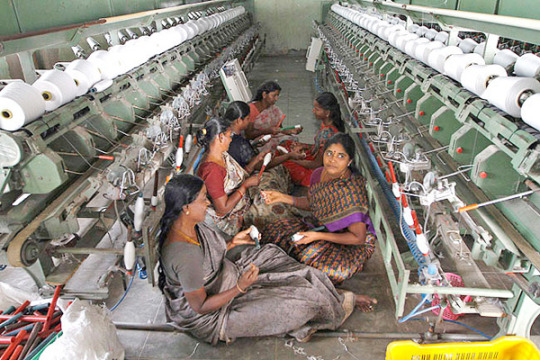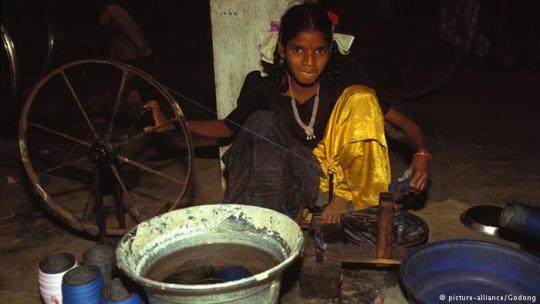#sumangali system
Text
Fashion Factfiles #3: The Sumangali System
Hey guys, happy February and welcome to another Fashion Factfiles blogpost!
The Fashion Factfiles is where we expose the brutal realities of the garment industry, the side that the big corporations and big names in fashion work hard to hide behind ‘girl power’ tees and ‘look at us recycling omg we duz care’ campaigns.
This month we’ll be highlighting an issue that many may not be familiar with, but is absolutely horrific and heartbreaking: the Sumangali System.
WARNING: Content regarding sexual abuse and suicide throughout.

Source: http://www.sify.com/news/sexual-abuse-in-textile-mill-help-us-write-tamil-nadu-women-news-national-qlbmpRabbcdgh.html
In Tamil Nadu, India, there are about 1600 spinning mills (where fibres are spun to make yarn- like the thread you see sold in Queens market), that employ around 400,000 workers. 90% of the workers are women, with about 60-70% aged 15-18.
Many of these women are employed through the Sumangali (married woman) Scheme; an employment scheme that is essentially bonded labour (when a person is forced to work to pay off a debt) and child labour.
Indeed, this scheme involves agents from spinning mills visiting impoverished families in the villages, recruiting young girls to work in the mills for a 3-5 year contract, with a promise lump sum of money at the end of the contract that they can use as dowry (money given to the bride’s husbands family when they get married- tradition in this area).
Parents are encouraged by the money, due to the desperate conditions many of these families are in, as well as the hefty amount of money required for their daughters’ dowry. Parents are ensured their daughters will be protected and kept ‘clean’ (i.e. no funny business, so they remain good potential wives). The spinning mills also provide accommodation and food in hostels near the mills, where the girls are required to stay.
Underprivileged, illiterate, and migrant women are the focus, as they are thought to be more submissive, and less demanding of higher wages (e.g. less likely to understand labour laws in the area or unable to articulate/speak out about problems). The majority are also from low-caste (mainly Dalit) communities in Tamil Nadu, putting them at risk of further exploitation, due to the pre-existing discrimination and vulnerability to exploitation faced by those of low-caste.
Indeed, what parents and workers are not aware of, is the sheer brutality and torture the young girls face. Listed below are just some examples of the poor treatment they endure.

source: http://www.dw.com/en/rampant-abuse-in-tamil-nadus-spinning-mills-study/a-19284995
POOR WORKING CONDITIONS
Excessive working hours, with an average of 12/13hrs a day, six days a week.
"They work at least 12 hours a day, and often it goes up to 16 hours. There is no fixed resting time and the food that is served is monotonous. This, in turn, leads to the women becoming quickly weak."
“I was promised that I could continue my studies, but instead was forced to work for 12 hours in a shift. Supervisors torture girls to extract work beyond their capacity.”
Extremely poor working environment.
“I had so many respiratory problems because of inhaling cotton all day. 15 of work hours in such high humidity, heavy noise of machines, claustrophobic rooms, dirty toilets and mandatory night shifts completely spoiled my health. A couple of my friends even had accidents because of exhaustion. They had to quit the jobs in a year or so and never got paid.”
The work is physically challenging, but also dangerous.
"They are also not given any protective gear, leading to injuries time and again.”
Women are sometimes locked in bathrooms or dark basements during audits to avoid poor working conditions being revealed.
One worker aged 16 was promised a job and steady income that would help support her economically desperate family. The working conditions seriously affected her health and she fell sick, but was forced by supervisors to continue working without any medical help. Her condition deteriorated and she ended up in hospital. After her recovery, her dad persuaded her to return to work, but after a few weeks, she begged her dad to take her home saying she would die otherwise, so he admitted her to hospital. However it was too late, and she died a day later.
POOR HOSTEL CONDITIONS
Wardens of hostels make sure workers go to work irrespective of their health. Wardens have also been found to physically beat female workers. In one case, wardens were found inspecting the girls’ sanitary pads to monitor pregnancies.
The hostels are found to be unhygienic, with toilets left uncleaned for weeks and lack of arrangements to dispose sanitary pads- in one study, sanitary pads were found dumped in the corner of every bathroom.
The rooms are overcrowded, with 10-15 workers sharing one room. They often sleep on thin mats, on the bare ground.

source: https://www.thenewsminute.com/article/photo-essay-how-tn-textile-mills-force-girls-bonded-labour-earn-dowry-67781
DENIAL OF BASIC RIGHTS
Extremely poor wages- according to one study, while monthly minimum wage amounts to about 113 euros, workers are paid only about 19 euros.
Workers are denied leave, even in family emergencies. 4-6 days are provided for major festivals, however workers must return within six days. Returning late will result in punishments, including wage deductions and overtime. Some workers have been exploited for more than six months for taking more than the stated days of leave.
Movement is restricted outside of their factory or hostel.
The women have no working contracts, factory identity cards, salary certificates or anything indicating their employment, meaning factories can get away with exploiting and firing workers more easily (no legal protections for workers without official employment, making it difficult to claim their rights e.g. claiming wages they may not be given). In fact, about 70-90% are actually employed as apprentices and remain apprentices, despite the law stating only 10% can be apprentices. This allows factories to keep them as unofficial employees as well as pay them less.
Workers are denied the right to form/join trade unions or demand better working conditions. In a 2016 study, 33/743 mills had a workers committee for workers to express grievances. This is made harder by the fact that they are located in rural areas, away from any existing trade unions and organisations to help.
If management are accused of maltreatment of workers, they go to great lengths keep it quiet. For example, withholding the girl’s wages and pay her only once the family drops the case. In other cases, they make up stories about the girl having an affair, and families are shamed into silence.
SEXUAL ABUSE
Girls in the Sumangali system are extremely vulnerable to sexual abuse. This was publicly exposed in 2016, when an eight-page letter from women in a textile mill was sent to Tamil Nadu’s social welfare officer, describing the abuse they endured.
“He forces himself on us, constantly hugging us and squeezing our breasts…Any worker who resists his advances loses part of her salary. We need this job and don't know who to talk to about the abuse we face everyday. Please help us.”
The sexual abuse experienced by workers was recently brought to the courts of Madras. It was revealed that women were being sexually harassed, with no means of seeking justice and no complaints committees. Horrific accounts included young girls aged 15 being locked in a room and abused by multiple men, and one girl aged 12 who was abused and made to have abortions.

source: https://www.thenewsminute.com/article/photo-essay-how-tn-textile-mills-force-girls-bonded-labour-earn-dowry-67781
SUICIDE
The conditions are so extremely dire, suicide has become frequent in this sector.
One worker recalls an incident she witnessed a year and a half ago, where a young girl threw herself off a roof, after a supervisor pulled down her skirt in front of other workers.
“About 30 of us saw this, but we were scared. Since the police did not file a case due to the management’s pressure, we did not think there was anything we could do.”
In 2016, a 17-year old girl was found unconscious in her room, with wound marks on her body and rope impressions around her neck. She had been working 4 hours of overtime everyday after her 8 hour shift, and was sexually harassed by a male worker. After one year she wanted to leave, but her parents convinced her to complete her contract.
After a report in 2014 highlighted the exploitation of these women under the Sumangali Scheme, the High Court of Madras ordered for it to be abolished. However, despite laws banning the employment of women under 18 years and a minimum wage being set, in reality, little has changed. In fact, a study in 2016 found that in 351/743 mills, Sumangali was still around, under different names and taking different forms.
Mills have begun luring young women into textile mills by promising free education, jewellery and trips abroad. They also encourage and ‘brainwash’ them into bringing their friends to the mills, taking over the job of the agents who would recruit among the villages. In one mill, a noticeboard was found promising workers a trip to a water theme park for every two girls they brought to the mill, and a silver anklet for every five girls.

source: https://www.thenewsminute.com/article/photo-essay-how-tn-textile-mills-force-girls-bonded-labour-earn-dowry-67781
Companies alleged to be involved in the schemes include: H&M, M&S, Next, Diesel, Old Navy (GAP), Timberland, Tommy Hilfiger, Primark, Tesco, Mothercare, and ASDA-Walmart. I’m not suggesting you boycott these brands, but instead inquire about their connection with the Sumangali System, and ask them what they’re doing to ensure their suppliers are not exploiting their workers.
While I have extreme hatred for factory managers and their systematic abuse of female workers, we need to hold these brands to account also. These mills are often subcontracted, that is, the brands sign agreements with one mill to produce a certain amount of yarn, however this mill then signs agreements (subcontracts) with another mill to meet the (extremely high) targets set by brands. This means that it is the contracted factory, rather than the initial mill or the brand, that is responsible for the maltreatment of the workers. This allows brands to avoid any blame or responsibility- hence why literally EVERY brand is out here subcontracting work.
It is absolutely vile that they are exploiting the desperation of impoverished families, knowing that individuals who are struggling to just keep their families fed will be reluctantly endure such conditions in order to meet their near impossible targets, to ensure the survival of their loved ones.

source: https://www.thenewsminute.com/article/photo-essay-how-tn-textile-mills-force-girls-bonded-labour-earn-dowry-67781
Please help us raise awareness of the suffering and strength of these women. Their stories deserve to be told.

source: http://www.thehindu.com/news/cities/Madurai/plea-to-ban-all-forms-of-bonded-labour-in-tamil-nadu/article4976950.ece
References and other important sources:
https://timesofindia.indiatimes.com/city/coimbatore/sumangali-scheme-still-alive-in-new-garb-allege-activists/articleshow/62245582.cms
https://timesofindia.indiatimes.com/city/chennai/looms-repackage-sumangali-to-lure-girls-into-child-labour/articleshow/62435629.cms
https://littleindia.com/forced-labor-prevalent-indian-factory-supplying-hugo-boss-report/
http://www.sify.com/news/sexual-abuse-in-textile-mill-help-us-write-tamil-nadu-women-news-national-qlbmpRabbcdgh.html
http://www.firstpost.com/india/sexual-harassment-debate-rages-but-little-help-for-women-employed-in-unorganised-sector-4216457.html
http://www.dw.com/en/rampant-abuse-in-tamil-nadus-spinning-mills-study/a-19284995
Rahul, N (2017). Gender and caste at work: Evolution of a factory regime under the sumangalfi scheme. Social Change, 47(1), pp. 28-44.
https://www.reuters.com/article/us-india-women-labour/death-of-teenage-indian-mill-worker-raises-concerns-over-bonded-labor-idUSKCN0WJ2BZ
https://www.thenewsminute.com/article/sumangali-scheme-when-marriage-assistance-becomes-bonded-labour-disguise-52320
https://www.solidaridadnetwork.org/sites/solidaridadnetwork.org/files/publications/Understanding_Sumangali_Scheme_in_Tamil_Nadu.pdf
https://www.fairwear.org/wp-content/uploads/2016/06/fwf-india-sumangalischeme.pdf
https://www.thenewsminute.com/article/photo-essay-how-tn-textile-mills-force-girls-bonded-labour-earn-dowry-67781
http://www.indianet.nl/pdf/FabricOfSlavery.pdf
Labour, Exploitation and Work-Based Harm by Sam Scott
#fashion#ethical fashion#ethical#ethicalfashion#fashion factfiles#fashionfactfiles#ohsoethical#oh so ethical#sumangali system#sumangalisystem#garment factory#garment industry#workers rights#workersrights#human rights#humanrights#india#tamil nadu#tamilnadu#labour#exploitation
2 notes
·
View notes
Text
ESSAY ON FAST FASHION
1. In your opinion, what is currently wrong with the fashion industry and what would you like to see change?
1. Garment quality is declining every year. As a result, our clothes immediately look faded, shapeless, or worn out.
2. Trends are changing so quickly that we cannot keep up. We continue to purchase just to stay up to date.
3. Clothing needs to be made with more sustainable products
4. Sustainable Garments have become extremely expensive therefore harder for people with less money to shop sustainably, these types of people are most likely to shop with fast fashion.
I would like to see more fashion brands looking at making their garments more sustainable by using greener products and looking at using recycled clothing.
In addition to this I would like to see more affordable products in the fashion industry.
2. What is fast fashion? What would brands need to do to steer away from implementing a fast fashion business plan?
Fast fashion can be defined as cheap, trendy clothing, that samples ideas from the catwalk or celebrity culture and turns them into garments in high street stores at breakneck speed to meet consumer demand. The idea is to get the newest styles on the market as fast as possible, so shoppers can snap them up while they are still at the height of their popularity, and then, sadly, discard them after a few wears. It plays into the idea that outfit repeating is a fashion faux pas, and that if you want to stay relevant, you have to sport the latest looks as they happen. It forms a key part of the toxic system of overproduction and consumption that has made fashion one of the largest polluters in the world.
Many of the retailers that we know today as fast fashion big players, like Zara or H&M, primark, SHEIN and AliExpress
3. What impact does the fashion industry have on the environment? What would brands need to do to improve their impact on the environment?
The fashion industry has a disastrous impact on the environment. In fact, it is the second largest polluter in the world, just after the oil industry. And the environmental damage is increasing as the industry grows.
However, there are solutions and alternatives to mitigate these problems. The first step lies in building awareness and willingness to change
In most of the countries in which garments are produced,untreated waste waters from textiles factories are dumped directly into the rivers.
Every time we wash a synthetic garment (polyester,nylon, etc), about 1,900 individual microfibers are released into the water, making their way into our oceans. Scientists have discovered that small aquatic organisms ingest those microfibers. These are then eaten by small fish which are later eaten by bigger fish, this introduces plastic to our food chain.
WHAT CAN WE DO ABOUT IT?
* Choose clothes made in countries with stricter environmental regulations for factories (EU, Canada, US...).
* Choose organic fibres and natural fibres that do not require chemicals to be produced.
* Choose sustainable brands
* Always wash new clothes before using them for the first time.
* Look for garments with certification label controlling chemical content such as OEKO-TEX®, GOTS, or BLUESIGN®
4. Discuss some examples of poor working conditions you find in the fashion industry. What would brands need to do to improve working conditions for their employees? Can you find any examples of brands with poor working conditions?
Many fashion brands assure their customers that the workers who made their clothing are paid "at least the minimum legal wage". But what exactly does that mean?
First of all, it means that many other brands do not even pay the minimum legal salary!
Furthermore, in most of the manufacturing countries (China, Bangladesh, India...), the minimum wage represents between half to a fifth of the living wage.
Garment workers are often forced to work 14 to 16 hours a day, 7 days a week. During peak season, they may work until 2-3am to meet the fashion brand's deadline. Their basic wages are so low that they cannot refuse overtime - aside from the fact that many would be fired if they refused to work overtime. In some cases, overtime is not even paid at all.
168 million children in the world are forced to work.Because the fashion industry requires low-skilled labour, child labour is particularly common in this industry.
In South India, for example, 250,000 girls work under the Sumangali scheme, a practice which involves sending young girls from poor families to work in a textile factory for three or five years in exchange for a basic wage and an lump sum payment at the end to pay for their dowry
In South India, for example, 250,000 girls work under the Sumangali scheme, a practice which involves sending young girls from poor families to work in a textile factory for three or five years in exchange for a basic wage and an lump sum payment at the end to pay for their dowry
1. Aeropostale is one of the largest American retailers of casual apparel and accessories. The company is known to use sweatshops for the fabrication of its clothing items. It has been involved in child labor scandals as well.
2. Adidas creates shoes, clothing, and accessories. Adidas is the second-largest sportswear manufacturer in the world after Nike.
3. ASOS is a British online fashion and cosmetic retailer, selling over 850 brands on its website as well as its clothing range and accessories. ASOS uses child-labor in Turkish factories and implements sweatshop-like production lines in their warehouses
4. Forever 21 is a fast fashion retailer headquartered in Los Angeles. Many consumers already boycott Forever 21 because of their use of sweatshops. Forever 21 makes a third of its clothing in the United States. But they are currently being accused of using sweatshop-like factories, underpaying their workers, having no compensation for overtime.
5. Lastly, what can you, as a fashion consumer, do to reduce your fashion environmental impact?
How to stop fast fashion
1. Shop second hand (Depop, charity shops)
2. Up cycle your own clothing
3. Shop green ( find sustainable brands)
4. Shop ethically online
5. Instead of throwing clothes away sell them second hand to contribute to helping stop fast fashion
6. Donate to charity shops
Personally I shop in all second hand shops like Depop and charity shops all my old clothing goes to my brothers children or gets donated to charity shops.
0 notes